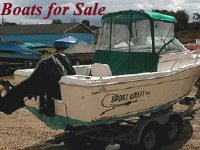|
Open Water Summer Walleyes
by Ron Anlauf
It's time to step back
and take a good look around if you want to get your
share of catching mid-summer walleyes. If you've tried everything you
know, in every possible place, you mave to dig a little deeper. What
you might not know or even expect is that many of the walleyes you've
been chasing are now suspended, and is a common occurence in most bodies
of water. It happens in natural lakes across the Midwest, the Great
Lakes, Canadian Shield lakes, and it happens in many reservoirs. The
thing is it's always a possibility, especially during the summer
period. your
share of catching mid-summer walleyes. If you've tried everything you
know, in every possible place, you mave to dig a little deeper. What
you might not know or even expect is that many of the walleyes you've
been chasing are now suspended, and is a common occurence in most bodies
of water. It happens in natural lakes across the Midwest, the Great
Lakes, Canadian Shield lakes, and it happens in many reservoirs. The
thing is it's always a possibility, especially during the summer
period.
Many anglers have a
hard time accepting the fact that walleyes often suspend far off the
bottom relating to nothing but their next meal. Sure they may have
heard about suspension on lakes like Erie, but they just don't consider
it when it comes to their home waters. Once you get past the skepticism
and start to believe you can get down to the jobof rounding up a few and
putting them in the boat.
From natural lakes to
the Great Lakes and even reservoirs, walleyes will often suspend when
the conditions are right. On some bodies of water walleyes may be
riding high one day and belly to the bottom the next. On others like
Erie, itís unusual to find them any other way than suspended, especially
during the summer months.
Suspension is
triggered by a high riding food source like shiners, shad, alewives,
ciscoes, and even perch. As seasonal temperatures continue to increase
and mid lake temperatures begin to pop up things start to happen that
get the whole process going.
Those warmer temps can
spur plankton productivity as well as trigger insect hatches all of
which will attract the aforementioned baitfish, which in turn will pull
in olí marble eyes. Wherever a solid bait source is found you can bet
the walleyes wonít be far behind, even it means leaving classic
structure like rock humps and quick drop offs in the dust.
Methods for rounding
up suspended walleyes can vary but the most efficient presentation is
trolling with either crankbaits or spinner rigs. Some anglers have
experienced success by using floating jig heads tipped with live bait
and using extra long leaders, like twenty feet or more. Itís a method
that approaches walleyes from the bottom up, and can be effective when
dealing with small groups of walleyes but it's not effecient when you
have too many acres of water to cover before you sleep. In that case it
would make more sense to opt for a faster more efficient approach, and
is where trolling crankbaits and spinners really come in. Crankbaits in
particular allow for a quick trolling pace and includes speeds up to
three mph or more, which allows anglers to cover a maximum amount of
water in the course of a day.
Selecting a crankbait
starts by picking one that you have faith in and feel confident that if
you run it past a walleye with an appetite that it will be accepted.
Confidence baits that lend themselves to tackling suspended walleyes
include Cotton Cordell Walleye Divers and Grappler Shads, as well as
Smithwick Deep Rouge Jrs. The Grappler Shads are particularly effective
at warp speeds and will run true at five mph or more. It also includes
selecting a bait that will run at a particular depth, especially if
youíre marking most of the fish in a narrow band. There are several
books and charts that are readily available like Precision Trolling,
that give specifics of particular baits which can help greatly with
determining running depth.
Spinners can also
provide for a quick trolling pace, especially if you use the proper
blade. Willow leaf blades are on top of the speed blade pile, while deep
cupped Coloradoís would be on the bottom. Colorado spinner rigs canít
take the pressure of a high speed run and will spin out resulting in a
twisted up mess, and of course no fish.
Another key to a
successful spinner presentation is getting it to run at a particular
depth. Spinners by themselves are shallow running and will need some
sort of weight to achieve any kind of depth. There are several ways to
get the job done but Team Crestliner member and professional walleye
angler Rick Olson has found that the easiest method includes the use of
an in-line weight and an eight or nine foot leader. "The in-line
weight keeps the whole process simple, and simple is good.
To vary depth you can
either vary the size of the weight your using, or adjust the amount of
line you let out." The ability to determine exact running depth
comes with practice, but getting close can be as easy as finding out how
much line it takes to get your rig to the bottom and adjusting from
there. The thing is you hardly ever have to have your bait running at
an exact depth to be productive as you will probably never find all of
the walleyes holding at the exact same depth at the exact same time.
Another consideration
is the fact that suspended walleyes can be extremely spooky and a pair
of trolling boards may be in order. In-line boards like Cannon's Rover
Board are relatively inexpensive and easy to use and will help get your
baits out and away from the boat where youíre more likely to encounter
active fish. Another advantage to using trolling boards is the ability
to increase the amount of coverage area by spreading out your baits,
and allowing you to take a wider swath.
Itís easy to get
confused with the whole suspended phenomenon but donít let it bother
you. The thing to do is relax and realize itís not and exact
science, and you donít have to be perfect to be successful. However to
be successful you do have to give it some time, and it could easily turn
out to be time well spent. See you on the water. |






 your
share of catching mid-summer walleyes. If you've tried everything you
know, in every possible place, you mave to dig a little deeper. What
you might not know or even expect is that many of the walleyes you've
been chasing are now suspended, and is a common occurence in most bodies
of water. It happens in natural lakes across the Midwest, the Great
Lakes, Canadian Shield lakes, and it happens in many reservoirs. The
thing is it's always a possibility, especially during the summer
period.
your
share of catching mid-summer walleyes. If you've tried everything you
know, in every possible place, you mave to dig a little deeper. What
you might not know or even expect is that many of the walleyes you've
been chasing are now suspended, and is a common occurence in most bodies
of water. It happens in natural lakes across the Midwest, the Great
Lakes, Canadian Shield lakes, and it happens in many reservoirs. The
thing is it's always a possibility, especially during the summer
period.